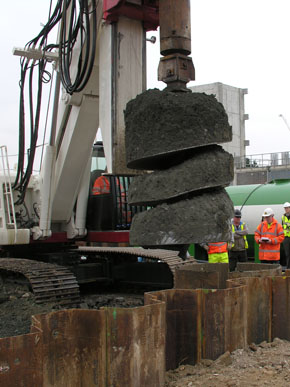Rotary bored piles differ from CFA piles in that a temporary casing is installed to support the bore from collapse in unstable ground conditions, for example in superficial soils.
Where casing lengths are short they can be inserted as a single plain length. Where longer lengths are required they can be inserted in segmental lengths joined together or as plain lengths using vibrators or oscillators.
Under certain conditions the use of long casings can be avoided by the use of support fluids to avoid collapse of the bore. Permanent casings can be specified where there is a particular requirement, for example to avoid load shedding onto adjacent structures, tunnels, etc.
In water bearing ground that cannot be sealed off with a casing the piles are concreted by the tremmie technique of upward displacement of the water.
The rig is fitted with a rotary boring unit which drives a kelly bar onto which drilling tools such as augers and core barrels are attached. The rig is able to apply a vertical downward (crowd) force to the kelly bar which means that rotary bored piles are particularly suited to drilling in hard strata, penetrating obstructions and drilling male secant piles.
Rotary bored piles are constructed in diameters typically ranging from 600mm to 2.4 metres and to depths in excess of 50.0 metres. They are used as bearing piles and in the construction of retaining walls - being installed as Contiguous, Secant and King Post piles. Since the rebar cage is inserted prior to concreting they can be quite substantial making the system ideal for lateral loading.
For top down construction they can be installed with Plunge Columns. Pile diameters are then often quite large to accommodate the high vertical loads, column size and construction tolerances associated with this system. The concrete is usually left at a low level to suit the basement level construction.


